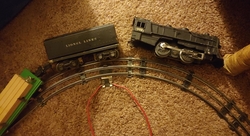When locomotives became capable of slow-speed running in our 3RO world, it got and kept a lot of people into the 3RO world who would have otherwise grown tired of all the childish (pardon me) Wheee! "railroading"; these would be the Hi-Railers, like me. Hi-Railers also tend to find the deepest pockets of all the sub-species of 3RO'ers. There are times, though, that I wish some of them would speed up that high-speed loco (we get it - it'll creep; okay, okay) where appropriate, and creep it - where appropriate
But - "scale speed" is the speed which the train is supposed at that place and time on the RR/layout. Unless you are moving through a yard or such, or hauling a massive number of non-expedited cars - as in a long coal drag - the train should move at a reasonable "track speed" rate. Now, the 80 smph Daylight above is running at a very typical Daylight 80 mph - but it looks too fast in a layout setting; 50 - 60 smph would probably convey the speed better, even if the real train sometimes went faster, which it did.
"Scale speed" is not slow, nor is it fast - it is accurate per an appropriate RR situation. Why there are not more model "speedometer cars" offered (wouldn't that be a lovely reason to offer a dynamometer car?, which has never shown up in 3RO), I do not know. They could be used anywhere, Pre-War to Right-Now.
I still have absolutely no use for 200 smph toy trains; I didn't have much use for it when I was a kid, either - it looked stupid. In the 50's, my broken-in 2055 Hudson wouldn't creep at 3 smph, but I didn't run it wide open much, either. Scale models? No, but much PW and some late Pre-War (263E, for example) Lionel equipment was a convincing evocation of railroading, before everything became bright colors, shiny, and 2-ounce cars.




![20190106_155110[1] 20190106_155110[1]](https://ogrforum.ogaugerr.com/fileSendAction/fcType/0/fcOid/82241647740451789/primaryPicture/true/filePointer/82241647742114958/fodoid/82241647742122630/imageType/SQUARE_THUMBNAIL/inlineImage/true/frame/FIRST/thumbnail.jpg)






